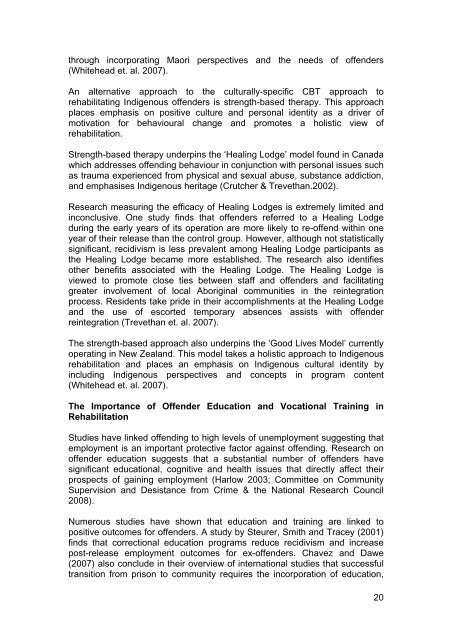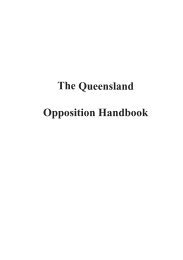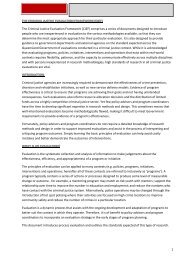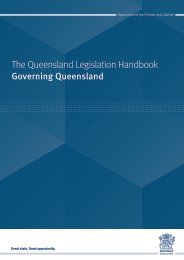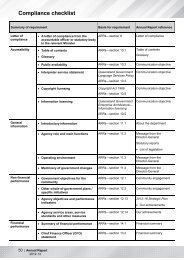Rehabilitative needs and treatment of Indigenous offenders in ...
Rehabilitative needs and treatment of Indigenous offenders in ...
Rehabilitative needs and treatment of Indigenous offenders in ...
Create successful ePaper yourself
Turn your PDF publications into a flip-book with our unique Google optimized e-Paper software.
through <strong>in</strong>corporat<strong>in</strong>g Maori perspectives <strong>and</strong> the <strong>needs</strong> <strong>of</strong> <strong>of</strong>fenders(Whitehead et. al. 2007).An alternative approach to the culturally-specific CBT approach torehabilitat<strong>in</strong>g <strong>Indigenous</strong> <strong>of</strong>fenders is strength-based therapy. This approachplaces emphasis on positive culture <strong>and</strong> personal identity as a driver <strong>of</strong>motivation for behavioural change <strong>and</strong> promotes a holistic view <strong>of</strong>rehabilitation.Strength-based therapy underp<strong>in</strong>s the ‘Heal<strong>in</strong>g Lodge’ model found <strong>in</strong> Canadawhich addresses <strong>of</strong>fend<strong>in</strong>g behaviour <strong>in</strong> conjunction with personal issues suchas trauma experienced from physical <strong>and</strong> sexual abuse, substance addiction,<strong>and</strong> emphasises <strong>Indigenous</strong> heritage (Crutcher & Trevethan.2002).Research measur<strong>in</strong>g the efficacy <strong>of</strong> Heal<strong>in</strong>g Lodges is extremely limited <strong>and</strong><strong>in</strong>conclusive. One study f<strong>in</strong>ds that <strong>of</strong>fenders referred to a Heal<strong>in</strong>g Lodgedur<strong>in</strong>g the early years <strong>of</strong> its operation are more likely to re-<strong>of</strong>fend with<strong>in</strong> oneyear <strong>of</strong> their release than the control group. However, although not statisticallysignificant, recidivism is less prevalent among Heal<strong>in</strong>g Lodge participants asthe Heal<strong>in</strong>g Lodge became more established. The research also identifiesother benefits associated with the Heal<strong>in</strong>g Lodge. The Heal<strong>in</strong>g Lodge isviewed to promote close ties between staff <strong>and</strong> <strong>of</strong>fenders <strong>and</strong> facilitat<strong>in</strong>ggreater <strong>in</strong>volvement <strong>of</strong> local Aborig<strong>in</strong>al communities <strong>in</strong> the re<strong>in</strong>tegrationprocess. Residents take pride <strong>in</strong> their accomplishments at the Heal<strong>in</strong>g Lodge<strong>and</strong> the use <strong>of</strong> escorted temporary absences assists with <strong>of</strong>fenderre<strong>in</strong>tegration (Trevethan et. al. 2007).The strength-based approach also underp<strong>in</strong>s the ‘Good Lives Model’ currentlyoperat<strong>in</strong>g <strong>in</strong> New Zeal<strong>and</strong>. This model takes a holistic approach to <strong>Indigenous</strong>rehabilitation <strong>and</strong> places an emphasis on <strong>Indigenous</strong> cultural identity by<strong>in</strong>clud<strong>in</strong>g <strong>Indigenous</strong> perspectives <strong>and</strong> concepts <strong>in</strong> program content(Whitehead et. al. 2007).The Importance <strong>of</strong> Offender Education <strong>and</strong> Vocational Tra<strong>in</strong><strong>in</strong>g <strong>in</strong>RehabilitationStudies have l<strong>in</strong>ked <strong>of</strong>fend<strong>in</strong>g to high levels <strong>of</strong> unemployment suggest<strong>in</strong>g thatemployment is an important protective factor aga<strong>in</strong>st <strong>of</strong>fend<strong>in</strong>g. Research on<strong>of</strong>fender education suggests that a substantial number <strong>of</strong> <strong>of</strong>fenders havesignificant educational, cognitive <strong>and</strong> health issues that directly affect theirprospects <strong>of</strong> ga<strong>in</strong><strong>in</strong>g employment (Harlow 2003; Committee on CommunitySupervision <strong>and</strong> Desistance from Crime & the National Research Council2008).Numerous studies have shown that education <strong>and</strong> tra<strong>in</strong><strong>in</strong>g are l<strong>in</strong>ked topositive outcomes for <strong>of</strong>fenders. A study by Steurer, Smith <strong>and</strong> Tracey (2001)f<strong>in</strong>ds that correctional education programs reduce recidivism <strong>and</strong> <strong>in</strong>creasepost-release employment outcomes for ex-<strong>of</strong>fenders. Chavez <strong>and</strong> Dawe(2007) also conclude <strong>in</strong> their overview <strong>of</strong> <strong>in</strong>ternational studies that successfultransition from prison to community requires the <strong>in</strong>corporation <strong>of</strong> education,20


